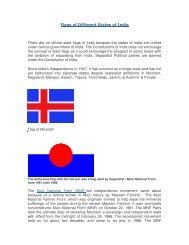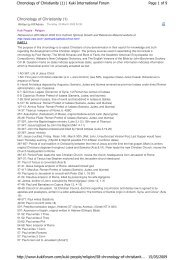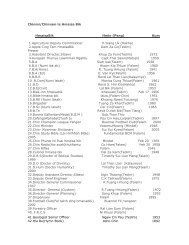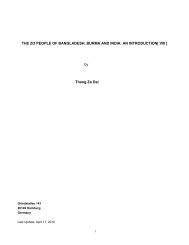The Geology of Burma - Zomi Online Library
The Geology of Burma - Zomi Online Library
The Geology of Burma - Zomi Online Library
Create successful ePaper yourself
Turn your PDF publications into a flip-book with our unique Google optimized e-Paper software.
Bibliography <strong>of</strong> <strong>Burma</strong>n Earth Science<br />
influenced the evolution <strong>of</strong> Cerberus Cuvier, a marine coastal snake<br />
belonging to the Homalopsinae (Oriental-Australian Rear-fanged Water<br />
Snakes). This study is an expansion <strong>of</strong> a previous study on the<br />
biogeography and systematics <strong>of</strong> Cerberus. Location: We obtained<br />
species from localities across the range <strong>of</strong> the widely distributed<br />
Cerberus: India, Sri Lanka, the Andaman islands, Myanmar, the<br />
Philippines, Borneo, Suluwesi, Sumatra, Vietnam, Thailand, Singapore<br />
and Australia. Methods: We analysed mtDNA sequences (12S, ND3,<br />
ATPase, 2338 nucleotide characters) from 21 localities. <strong>The</strong> sample<br />
consisted <strong>of</strong> 65 Cerberus rynchops (Schneider), three Cerberus<br />
australis (Gray) and four Cerberus microlepis Boulenger. One<br />
Homalopsis buccata (Linnaeus), one Bitia hydroides Gray, one<br />
Enhydris enhydris (Schneider), and two Enhydris plumbea (Boie) were<br />
used as outgroups. Results: We produced phylogenetic trees based on<br />
parsimony, maximum likelihood and Bayesian analysis. We did not find<br />
unambiguous support for the monophly <strong>of</strong> Cerberus. Cerberus austalis,<br />
H. buccata and all other Cerberus populations formed a three-way<br />
basal polytomy under parsimony and C. australis formed the sister<br />
group to a clade consisting <strong>of</strong> H. buccata and all other Cerberus in<br />
likelihood and Bayesian analysis. <strong>The</strong> non-Australian Cerberus were<br />
monophyletic and consisted <strong>of</strong> four primary biogeographical clades:<br />
Indian and Mayanmar, Philippines, Greater Sunda Islands and<br />
Suluwesi, and the Thai-Malay peninsula and Gulf <strong>of</strong> Thailand. <strong>The</strong><br />
range <strong>of</strong> genetic divergence between these clades and Australian<br />
Cerberus was 0.06-0.12. Genetic divergence among clades to the west<br />
<strong>of</strong> Australia was less pronounced (Thai-Malay peninsula and Gulf <strong>of</strong><br />
Thailand = 0.02-0.05; Sunda Islands and Suluwesi = 0.02-0.05;<br />
Philippines = 0.02-0.06; India and Myanmar = 0.04-0.06, Philippines<br />
= 0.02-0.5). Main conclusions: Gyi [University <strong>of</strong> Kansas Publications,<br />
Museum <strong>of</strong> Natural History 20 (1970), 47] recognized three species <strong>of</strong><br />
Cerberus: C. australis (from Australia), C. microlepis (known only from<br />
Lake Buhi in the Philippines), and the widely distributed C. rynchops<br />
(India to Wallacea). We did not find strong support for the monophyly<br />
<strong>of</strong> the genus. Cerberus australis is highly divergent from all other<br />
Cerberus lineages sampled from this region. <strong>The</strong> geographically<br />
widespread C. rynchops is resolved into four biogeographical clades<br />
(Indian and Myanmar, Philippines, Greater Sunda Islands and<br />
September 2008 36







